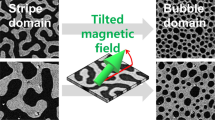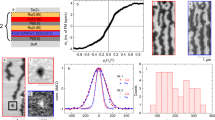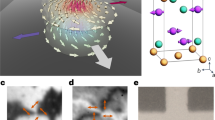Abstract
Magnetic skyrmions are promising as next-generation information units. Their antiparticle—the antiskyrmion—has also been discovered in chiral magnets. Here we experimentally demonstrate antiskyrmion sliding in response to a pulsed electric current at room temperature without the requirement of an external magnetic field. This is realized by embedding antiskyrmions in helical stripe domains, which naturally provide one-dimensional straight tracks along which antiskyrmion sliding can be easily launched with low current density and without transverse deflection from the antiskyrmion Hall effect. The higher mobility of the antiskyrmions in the background of helical stripes in contrast to the typical ferromagnetic state is a result of intrinsic material parameters and elastic energy of the stripe domain, thereby smearing out the random pinning potential, as supported by micromagnetic simulations. The demonstration and comprehensive understanding of antiskyrmion movement along naturally straight tracks offers a new perspective for (anti)skyrmion application in spintronics.
This is a preview of subscription content, access via your institution
Access options
Access Nature and 54 other Nature Portfolio journals
Get Nature+, our best-value online-access subscription
$29.99 / 30 days
cancel any time
Subscribe to this journal
Receive 12 print issues and online access
$259.00 per year
only $21.58 per issue
Buy this article
- Purchase on Springer Link
- Instant access to full article PDF
Prices may be subject to local taxes which are calculated during checkout




Similar content being viewed by others
Data availability
The data that support the findings of this study are available within the Article and its Supplementary Information. Any other relevant data are available from the corresponding authors upon reasonable request.
References
Bogdanov, A. N. & Yablonskii, D. Thermodynamically stable ‘vortices’ in magnetically ordered crystals. The mixed state of magnets. Zh. Eksp. Teor. Fiz. 95, 178–182 (1989).
Mühlbauer, S. et al. Skyrmion lattice in a chiral magnet. Science 323, 915–919 (2009).
Yu, X. et al. Real-space observation of a two-dimensional skyrmion crystal. Nature 465, 901–904 (2010).
Koshibae, W. & Nagaosa, N. Theory of antiskyrmions in magnets. Nat. Commun. 7, 10542 (2016).
Nayak, A. K. et al. Magnetic antiskyrmions above room temperature in tetragonal Heusler materials. Nature 548, 561–566 (2017).
Fert, A., Reyren, N. & Cros, V. Magnetic skyrmions: advances in physics and potential applications. Nat. Rev. Mater. 2, 17031 (2017).
Iwasaki, J., Mochizuki, M. & Nagaosa, N. Current-induced skyrmion dynamics in constricted geometries. Nat. Nanotechnol. 8, 742–747 (2013).
Tomasello, R. et al. A strategy for the design of skyrmion racetrack memories. Sci. Rep. 4, 6784 (2014).
Parkin, S. & Yang, S.-H. Memory on the racetrack. Nat. Nanotechnol. 10, 195–198 (2015).
Grollier, J. et al. Neuromorphic spintronics. Nat. Electron. 3, 360–370 (2020).
Zhou, Y. Magnetic skyrmions: intriguing physics and new spintronic device concepts. Natl Sci. Rev. 6, 210–212 (2019).
Nagaosa, N. & Tokura, Y. Topological properties and dynamics of magnetic skyrmions. Nat. Nanotechnol. 8, 899–911 (2013).
Schulz, T. et al. Emergent electrodynamics of skyrmions in a chiral magnet. Nat. Phys. 8, 301–304 (2012).
Leonov, A. et al. The properties of isolated chiral skyrmions in thin magnetic films. New J. Phys. 18, 065003 (2016).
Hoffmann, M. et al. Antiskyrmions stabilized at interfaces by anisotropic Dzyaloshinskii–Moriya interactions. Nat. Commun. 8, 308 (2017).
Kovalev, A. A. & Sandhoefner, S. Skyrmions and antiskyrmions in quasi-two-dimensional magnets. Front. Phys. 6, 98 (2018).
Sampaio, J., Cros, V., Rohart, S., Thiaville, A. & Fert, A. Nucleation, stability and current-induced motion of isolated magnetic skyrmions in nanostructures. Nat. Nanotechnol. 8, 839–844 (2013).
Jiang, W. et al. Blowing magnetic skyrmion bubbles. Science 349, 283–286 (2015).
Müller, J. et al. Magnetic skyrmions and skyrmion clusters in the helical phase of Cu2OSeO3. Phys. Rev. Lett. 119, 137201 (2017).
Karube, K. et al. Room-temperature antiskyrmions and sawtooth surface textures in a non-centrosymmetric magnet with S4 symmetry. Nat. Mater. 20, 335–340 (2021).
Saha, R. et al. Intrinsic stability of magnetic anti-skyrmions in the tetragonal inverse Heusler compound Mn1.4Pt0.9Pd0.1Sn. Nat. Commun. 10, 5305 (2019).
Huang, S. et al. Stabilization and current-induced motion of antiskyrmion in the presence of anisotropic Dzyaloshinskii–Moriya interaction. Phys. Rev. B 96, 144412 (2017).
Jiang, W. et al. Direct observation of the skyrmion Hall effect. Nat. Phys. 13, 162–169 (2016).
Litzius, K. et al. Skyrmion Hall effect revealed by direct time-resolved X-ray microscopy. Nat. Phys. 13, 170–175 (2017).
He, Z. et al. Visualizing emergent magnetic flux of antiskyrmions in Mn1.4PtSn magnet. Adv. Funct. Mater. 32, 2112661 (2022).
Zhang, X. et al. Skyrmion-skyrmion and skyrmion-edge repulsions in skyrmion-based racetrack memory. Sci. Rep. 5, 7643 (2015).
Reichhardt, C. & Reichhardt, C. O. Depinning and nonequilibrium dynamic phases of particle assemblies driven over random and ordered substrates: a review. Rep. Prog. Phys. 80, 026501 (2016).
Vir, P. et al. Tetragonal superstructure of the antiskyrmion hosting Heusler compound Mn1.4PtSn. Chem. Mater. 31, 5876–5880 (2019).
Ma, T. et al. Tunable magnetic antiskyrmion size and helical period from nanometers to micrometers in a D2d Heusler compound. Adv. Mater. 32, 2002043 (2020).
Ishizuka, K. & Allman, B. Phase measurement of atomic resolution image using transport of intensity equation. J. Electron Microsc. 54, 191–197 (2005).
Peng, L. et al. Controlled transformation of skyrmions and antiskyrmions in a non-centrosymmetric magnet. Nat. Nanotechnol. 15, 181–186 (2020).
Hirsch, P., Horne, R. & Whelan, M. Direct observations of the arrangement and motion of dislocations in aluminium. Philos. Mag. 1, 677–684 (1956).
Anderson, P. M., Hirth, J. P. & Lothe, J. Theory of Dislocations (Cambridge Univ. Press, 2017).
Schoenherr, P. et al. Topological domain walls in helimagnets. Nat. Phys. 14, 465–468 (2018).
Chuang, I., Durrer, R., Turok, N. & Yurke, B. Cosmology in the laboratory: defect dynamics in liquid crystals. Science 251, 1336–1342 (1991).
Zapotocky, M., Ramos, L., Poulin, P., Lubensky, T. & Weitz, D. Particle-stabilized defect gel in cholesteric liquid crystals. Science 283, 209–212 (1999).
Brazovskii, S. & Nattermann, T. Pinning and sliding of driven elastic systems: from domain walls to charge density waves. Adv. Phys. 53, 177–252 (2004).
Tang, J. et al. Magnetic skyrmion bundles and their current-driven dynamics. Nat. Nanotechnol. 16, 1086–1091 (2021).
Wang, W. et al. Electrical manipulation of skyrmions in a chiral magnet. Nat. Commun. 13, 1593 (2022).
Peng, L. et al. Dynamic transition of current-driven single-skyrmion motion in a room-temperature chiral-lattice magnet. Nat. Commun. 12, 6797 (2021).
Yu, G. et al. Room-temperature skyrmion shift device for memory application. Nano Lett. 17, 261–268 (2017).
Nabarro, F. Fifty-year study of the Peierls–Nabarro stress. Mater. Sci. Eng. A 234, 67–76 (1997).
Blatter, G., Feigel’man, M. V., Geshkenbein, V. B., Larkin, A. I. & Vinokur, V. M. Vortices in high-temperature superconductors. Rev. Mod. Phys. 66, 1125 (1994).
Ezawa, M. Compact merons and skyrmions in thin chiral magnetic films. Phys. Rev. B 83, 104416 (2011).
Lin, S.-Z., Saxena, A. & Batista, C. D. Skyrmion fractionalization and merons in chiral magnets with easy-plane anisotropy. Phys. Rev. B 91, 224407 (2015).
Yu, X. et al. Transformation between meron and skyrmion topological spin textures in a chiral magnet. Nature 564, 95–98 (2018).
Jani, H. et al. Antiferromagnetic half-skyrmions and bimerons at room temperature. Nature 590, 74–79 (2021).
Hirata, Y. et al. Vanishing skyrmion Hall effect at the angular momentum compensation temperature of a ferrimagnet. Nat. Nanotechnol. 14, 232–236 (2019).
Iwasaki, J., Mochizuki, M. & Nagaosa, N. Universal current-velocity relation of skyrmion motion in chiral magnets. Nat. Commun. 4, 1463 (2013).
Vansteenkiste, A. et al. The design and verification of MuMax3. AIP Adv. 4, 107133 (2014).
Zhang, S. & Li, Z. Roles of nonequilibrium conduction electrons on the magnetization dynamics of ferromagnets. Phys. Rev. Lett. 93, 127204 (2004).
Acknowledgements
We would like to thank Z. Zhong for helpful discussion. This work was supported by the Strategic Priority Research Program of the Chinese Academy of Sciences (grant no. XDB33030100 to Y.Z.), the Science Centre of the National Science Foundation of China (grant no. 52088101 to Y.Z. and B.S.), the National Natural Science Foundation of China (nos. 52271195 to Y.Z., 52130103 to Y.Z. and S.W., 51925605 to J.S. and 52225106 to C.S.) and the CAS Project for Young Scientists in Basic Research (no. YSBR-084 to Y.Z.). The work at Los Alamos National Lab was carried out under the auspices of the US Department of Energy (DOE) NNSA under contract no. 89233218CNA000001 to S.-Z.L. through the LDRD Program, and was performed, in part, at the Center for Integrated Nanotechnologies, an Office of the Science User Facility, operated for the US DOE Office of Science, under user proposal nos. 2018BU0010 and 2018BU0083 to S.-Z.L.
Author information
Authors and Affiliations
Contributions
Y.Z. and B.S. supervised the project. Z.H., Z.C. and Z.W. synthesized the Mn1.4PtSn bulk crystals. Z.H. and Y.Z. performed the L-TEM observation. Z.H., Z.L. and S.-Z.L. performed the micromagnetic simulation. Z.H., S.-Z.L., J.C. and Y.Z. analysed the experimental data and plotted the figures. Z.H., S.-Z.L. and Y.Z. wrote the manuscript after discussing the data with J.S., S.W., C.S., T.Z., J.C. and B.S.
Corresponding authors
Ethics declarations
Competing interests
The authors declare no competing interests.
Peer review
Peer review information
Nature Materials thanks the anonymous reviewers for their contribution to the peer review of this work.
Additional information
Publisher’s note Springer Nature remains neutral with regard to jurisdictional claims in published maps and institutional affiliations.
Supplementary information
Supplementary Information
Supplementary Notes I–III and Figs. 1–14.
Supplementary Video 1
Antiskyrmion sliding along the straight stripe domain at a current density of je = 4.3 × 109 A m–2 at zero field and room temperature.
Supplementary Video 2
Direction reversal of antiskyrmion movement when the pulse current (je = 4.3 × 109 A m–2) is reversed to the opposite direction.
Supplementary Video 3
Current-driven behaviour of a meron pair along a helical stripe at a current density of je = 6.8 × 109 A m–2 at zero field and room temperature.
Rights and permissions
Springer Nature or its licensor (e.g. a society or other partner) holds exclusive rights to this article under a publishing agreement with the author(s) or other rightsholder(s); author self-archiving of the accepted manuscript version of this article is solely governed by the terms of such publishing agreement and applicable law.
About this article
Cite this article
He, Z., Li, Z., Chen, Z. et al. Experimental observation of current-driven antiskyrmion sliding in stripe domains. Nat. Mater. (2024). https://doi.org/10.1038/s41563-024-01870-8
Received:
Accepted:
Published:
DOI: https://doi.org/10.1038/s41563-024-01870-8



